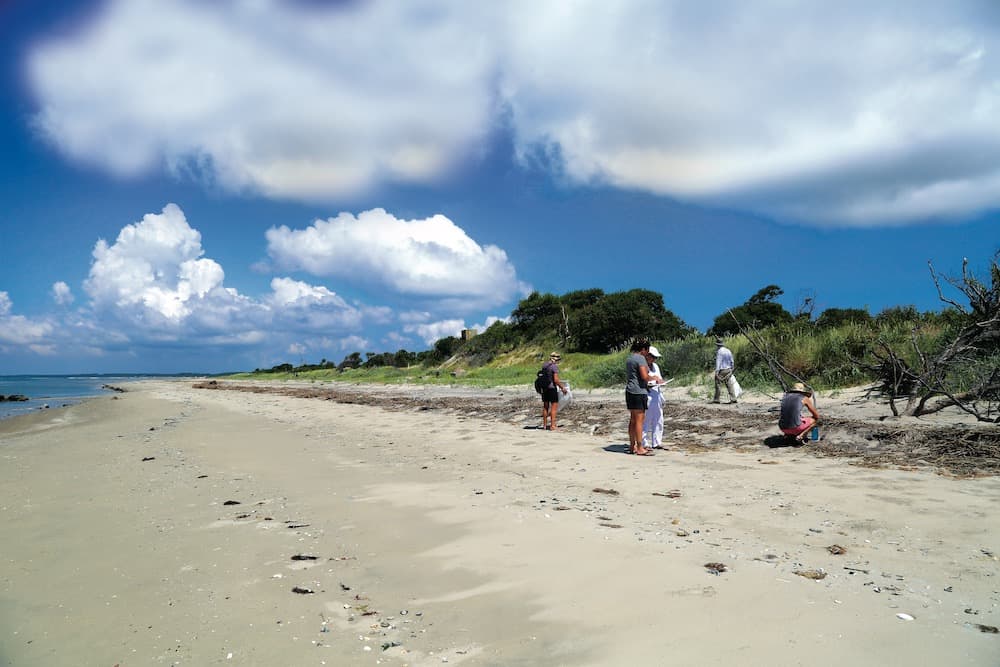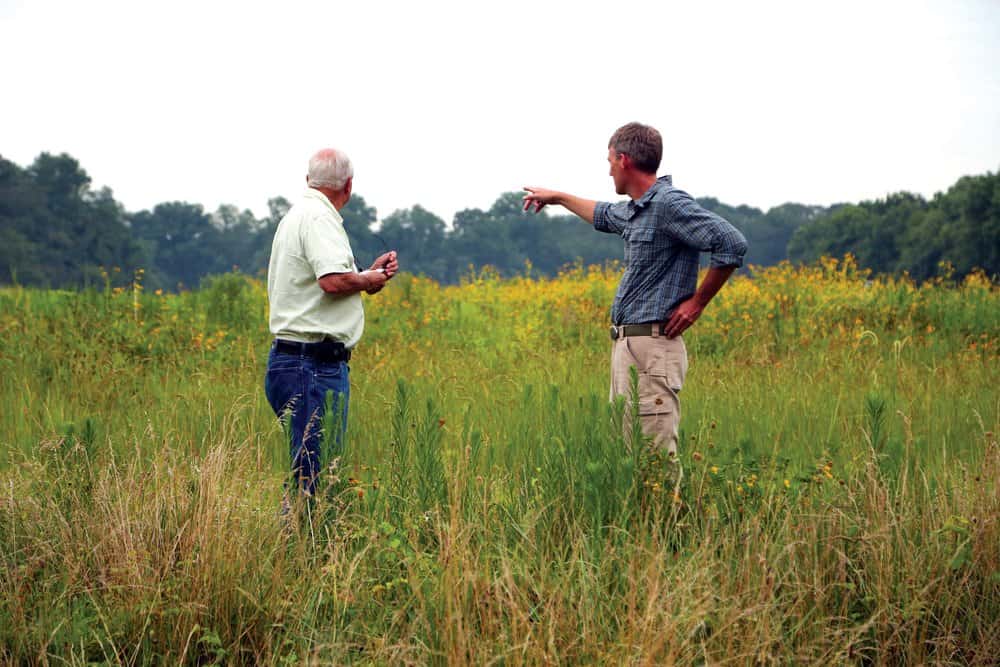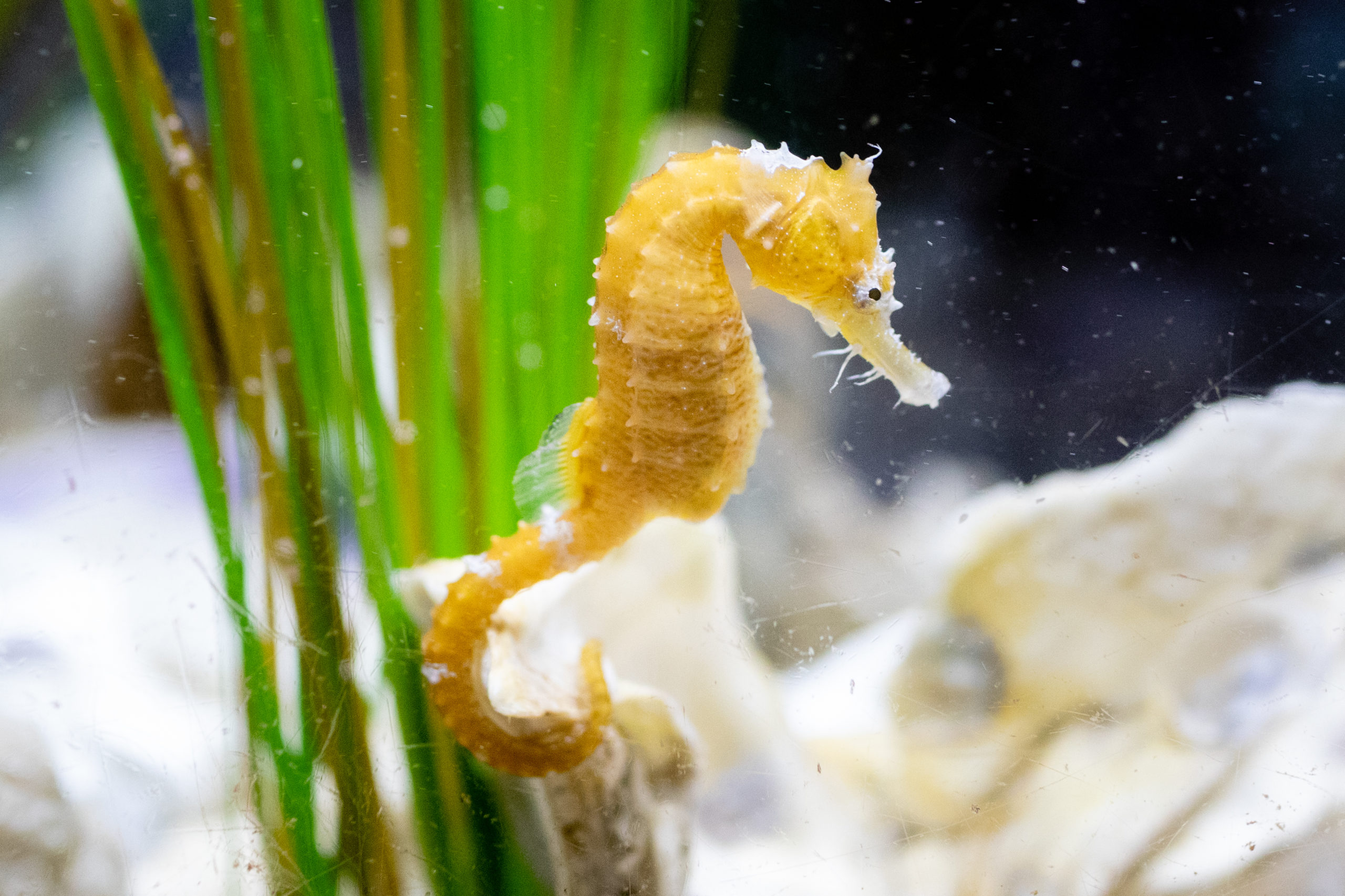Gardening for the Chesapeake might conjure an image of oyster gardening— tiny spat lovingly planted on shell in semi-strategically located underwater reef gardens. (It’s actually animal husbandry, but oyster husbanding sounds weird). Those scrumptious little critters, a keystone species, once filtered the entire Bay in only a few days. Sadly no more, as the population has dwindled. But important as oysters are as aquatic filters, even at their height they were only one piece of the total water-quality puzzle. Another big piece is stormwater, or runoff management, which involves actual, plant-based, on-shore gardening.
 Wild blue indigo ( baptisia australis ) blooms in May in alluvial thickets, stream banks and sandy floodplains in the Chesapeake Bay watershed. Photo by Kellen McCluskey
Wild blue indigo ( baptisia australis ) blooms in May in alluvial thickets, stream banks and sandy floodplains in the Chesapeake Bay watershed. Photo by Kellen McCluskey
“Stormwater management has to do with holding water on-site to stop pollution and silting,” says Steve Torgerson, associate at A. Morton Thomas and Associates, an engineering and design firm headquartered in Rockville, Md. “One of the keys is to slow down water; getting water to sink in and filter through the substrata.” That’s where terrestrial plants come in. For thousands of years, the watershed boasted rich native plant communities—majestic sycamores, shrubby pawpaws laden with fruit; lacy, white-bloomed shadblow (also known as serviceberry); graceful native grasses, and much, much more, whose roots clung to the soil and sucked up stormwater, preventing silt and pollutants from entering the tributaries and Bay. Over time, we’ve obliterated these natural buffers. Riparian forests have been felled, broad swathes of land have been cleared for tillage, cities and suburbs have paved over what was once meadow and wildlife habitat. Many wetlands, vital cogs in the system, have been filled in, though some—like the one in Adkins Arboretum, a 400-acre native garden in Tuckahoe State Park in Ridgely, Md.—have been preserved.
“Our most prominent feature here is our wetland—a great way to slow the water down, and let it infiltrate into the water table,” says Kathy Thornton, Land Steward at Adkins. The arboretum boasts 600 species of native shrubs, trees, wildflowers and ferns that for centuries populated Chesapeake buffers. Today this horticultural abundance offers a wealth of options and visual possibilities for new, human-planted buffers. “Some don’t want to block their view with trees, so the planting could be herbaceous grasses that stay relatively low,” Thornton says. “Native warm-season grasses tend to have extensive root systems that bunker the soil in and help prevent erosion.”
 Wetland boardwalk at the Adkins Arboretum near Ridgely, Md. Photo by Kellen McCluskey
Wetland boardwalk at the Adkins Arboretum near Ridgely, Md. Photo by Kellen McCluskey
Native grasses are also delightful to sit by with a drink (gin-and-tonic comes to mind) as they whisper in the evening breeze. There’s time for that indulgence because native plants are low maintenance. “Native plants tend to require less water and less fertilizer,” Thornton says. “That in itself is great for the Bay. And we don’t have to irrigate as often. You may water-in a new planting, but once established, it’s low maintenance. It’s the key thing that helps people get enthusiastic about natives. They’ve evolved to live here. They are self-sufficient.”
Plus, natives are a plant-it-and-they-will-come proposition, drawing and sustaining important pollinators and other wildlife. “Natives are a wonderful way to attract wildlife,” Thornton says, “Whether it’s the birds, or small mammals…the quail. Part of that is planting a variety of types of native plants.” There’s nothing like the magic of an up-close-and-personal view of a Monarch butterfly fluttering on the clustered pink bloom of a common milkweed right outside your door. In addition to the magic, there’s a satisfying sense of virtue.
Including native plants in your landscape is part of the University of Maryland Extension (UME) Bay-Wise program, which was developed by Extension Educator Wanda MacLachlan. “What I wanted to do was create a holistic approach to land management,” MacLachlan explains. Financed in part through a grant from the Chesapeake Bay Trust, Bay-Wise has been teaching people how to be water-quality-conscious stewards of their landscapes for over 20 years. “We started training master gardeners for Bay-Wise in 1996,” says MacLachlan. “We tailored it to train master gardeners because there are so many of them, and they could go forth with the work.”

Local master gardeners will walk through a property with the owner or resident to assess the space with an eye to certifying it as Bay-Wise, which nets you a dapper little sign to show off to the neighbors. MacLachlan adapted the UME Bay-Wise Yardstick, a checklist of Bay-centric practices, from a University of Florida workbook and initiated the certification process in imitation of a program in Virginia. “They’d certify a landscape as being environmentally sound,” she says, “using IPM [Integrated Pest Management], planting wisely and fertilizing wisely.”
Fertilizing wisely is particularly important. As Chesapeake Bay restoration and preservation movements gained momentum, farmers were censured for excessive nutrient runoff, primarily nitrogen and phosphorous, which produce summer algae blooms and consequential dead zones in the Bay. Since 2001, farmers have filed nutrient management plans, carefully calculating crop fertilizer needs and nutrient uptake. It’s both pennywise and Bay wise. Now much of the Bay’s nutrient overload comes from lawns and turf grass as 44 percent of fertilizer purchased in Maryland goes onto lawns. To address that piece, Maryland implemented the Lawn Fertilizer Law in 2013, which limits the amount of fertilizer that can be applied to lawns or turf. While lawn service companies know they must be licensed to apply fertilizer, many homeowners, unaware of the law and its science-based limits, routinely fertilize their own lawns whether they need to or not. Few have ever had a soil test done.
 Native plants like skunk cabbage help prevent erosion, and slow and filter runoff before it enters the water table. Photo by Kellen McCluskey
Native plants like skunk cabbage help prevent erosion, and slow and filter runoff before it enters the water table. Photo by Kellen McCluskey
Land use, water quality, animal and human health all connect—something marine biologist and environmentalist Rachel Carson observed in her Conservation in Action series, written in the 1940’s for the U.S. Fish and Wildlife Service. “Wildlife, water, forests, grasslands—all are part of man’s essential environment; the conservation and effective use of one is impossible except as the others are also conserved.” Recognizing this, more and more individuals and organizations are collaborating on a range of shore-side initiatives around the Chesapeake. For example, the Eastern Shore Land Conservancy has joined Envision the Choptank, a program designed to enhance the health and productivity of native oysters in the Choptank River through land stewardship. The program encourages residents to test their soil, install native plants, rain gardens and rain barrels—all of which are right out of the Bay-Wise playbook. Each of these steps, or “inches” in Yardstick parlance, helps diminish pollution and improve water quality.
“Each landscape adds,” MacLachlan notes. “Plus, if enough residents do it and record it, it can be used against the county’s TMDL [Total Maximum Daily Load of Pollutants] and WIP [Watershed Implementation Plan] that are required by the state.”
As of last December, there were 2,850 Bay-Wise certified gardens in Maryland, including 238 in Baltimore. While it’s easy to see how to create beautiful and effective buffers on lawn-rich properties, it’s harder in urban concentrations of impervious surfaces—roofs, playgrounds, driveways, roads, alleyways—which sluice all manner of toxic chemistry, to say nothing of trash and the occasional python, into the storm drains and from there into the Bay. But it can be done.
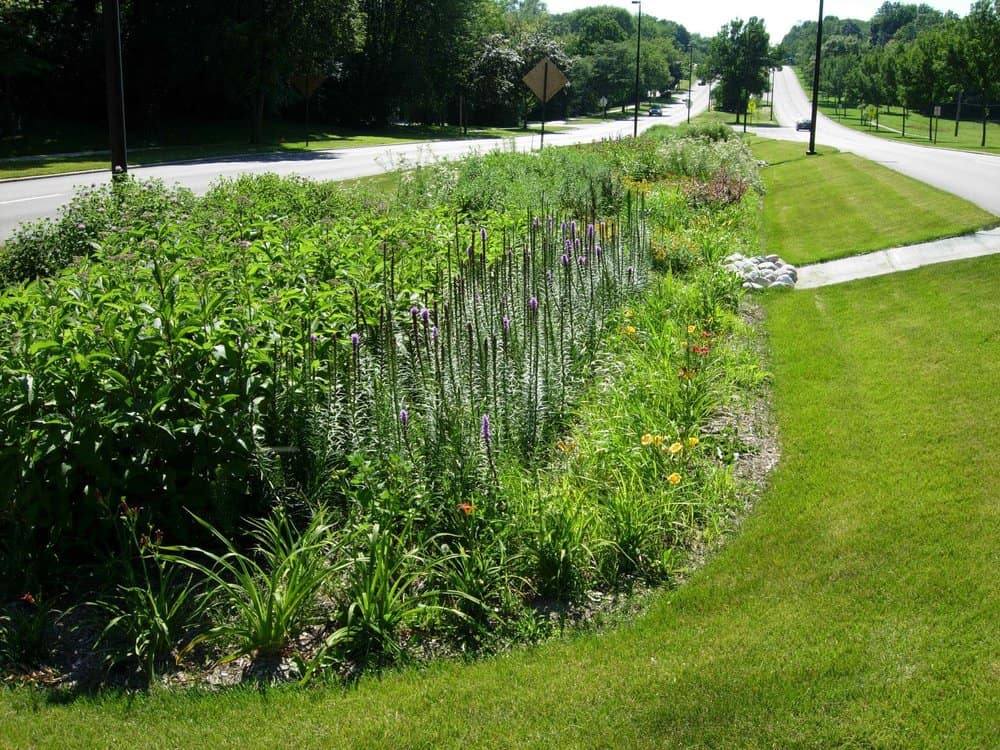 Bioswales are designed to capture and treat stormwater. Photo by Aaron Volkening
Bioswales are designed to capture and treat stormwater. Photo by Aaron Volkening
Which is why the Chesapeake Bay Foundation (CBF) is collaborating with the City of Baltimore to create Environmental Impact Bonds (EIB’s),
a tax-exempt bond first used in Washington D.C. to finance improvement in D.C.’s sewer overflows. The bond has a pay-for-success feature, wherein a portion of the payment is based on the level of achievement of specified indicators. Baltimore’s EIB’s will help fund more than 90 stormwater management projects in neighborhoods and at schools. “This innovative financing can produce a triple win for investors, for city taxpayers, and for the environment,” says CBF President Will Baker. “Cities and counties can scale up these green spaces to improve the quality of life in neighborhoods, and also to reduce pollution. Polluted runoff will be channeled through these spaces, allowing nature to soak up the water, and plants to soak up contaminants.”
The Baltimore program will begin by eliminating some impervious surface. “What we’re doing first and foremost is tearing up hard surface that serves no real purpose in a neighborhood,” explains Jeffrey Raymond, Chief of Communications and Community Affairs in Baltimore’s Department of Public Works. “It’s to the community’s benefit in greening the community to make it look better, to make [the space] more of a useful amenity instead of an occasional parking lot or someplace to put out the trash cans. And even to the extent of cooling the area.”
Studies have shown that increased tree canopy in urban settings can create ambient cooling effects between three and seven degrees Fahrenheit. “It’s also going to go a long way toward helping us meet our MS4 [municipal storm sewer] goals,” Raymond adds.
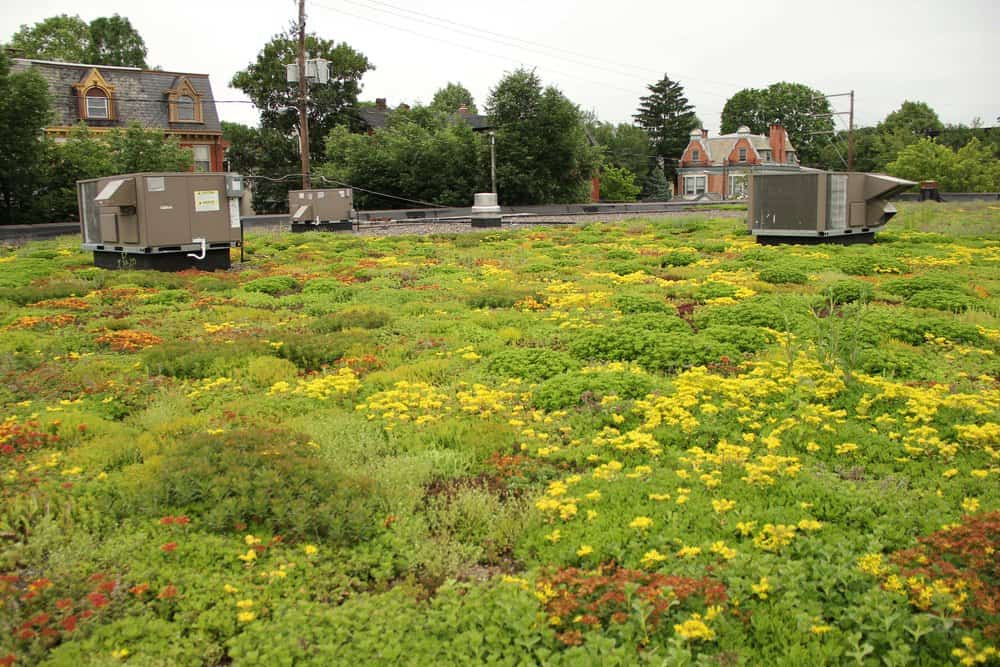 This green roof in Lancaster, Pa., is part of the town’s plan for reducing Chesapeake tributary pollution. Photo by Steve Droter/Chesapeake Bay Program
This green roof in Lancaster, Pa., is part of the town’s plan for reducing Chesapeake tributary pollution. Photo by Steve Droter/Chesapeake Bay Program
The projects in Baltimore will cost $10.3 million, a significant chunk. But in addition to the significant but less-easily-measured ambience and encouragement that green spaces offer a community, a well-implemented green plan can also save significant municipal money. Twenty years ago, Portland, Oregon, which gets about 37 inches of rain annually, was threatened with a lawsuit for polluting the Willamette River with combined stormwater and sewer overflow. They began trying to engineer their way out of the problem by upsizing the municipal piping system. When they realized that there was a limit to upsizing, they incorporated a greener approach, including green roofs, green streets, rain gardens, and bioswales, which are broad drainage courses usually planted with a mix of natives and nativars (cultivars of native plants). And, they asked residents to disconnect their downspouts from the storm drain system. This multi-pronged attack considerably diminished the problem and netted approximately $65 million in savings for the municipality.
But green solutions work only if done with a knowledge of the science, including soil characteristics and the systems in the surrounding landscape. In Seattle, a series of rain gardens failed because the drainage in the soil was inadequate to the plants that were installed. “The plants were inundated for a week instead of 24-to-48 hours, and they died,” says Joan Iverson Nassauer, professor of landscape architecture at University of Michigan. “It was all because they didn’t understand the science. It’s a mini-ecosystem that functions together.”
For example, we can’t just plug in a rain garden at every damp corner or downspout. For one thing, a rain garden needs to be at least 10 feet from the house so you don’t flood the basement. But in addition to being functional, it needs to be beautiful. “You have to make these things look attractive, so they are publicly accepted and add to the aesthetics of our community,” says Emily Hauth, a stormwater specialist in Portland’s Sustainable Stormwater Management Program.
Native plants lend themselves to a kind of English cottage garden effect rather than a manicured estate look, (though a wide swath of warm season grasses along a shore is distinctly estate-looking). One way to ensure that a mixture of open-form native plantings is perceived as beautiful is a carefully defined perimeter. “People are more willing to look at a kind of messy landscape if it is bound within an orderly frame,” says Nassauer. “If the edge of your landscape is kempt, what you put on the inside can be messier and less trimmed. It still looks to the casual observer that it’s a beautiful landscape.” Nassauer also notes that telling the story of the space is an important component in community appreciation. “Signage,” she says. “An interpretive panel that can tell the story. People need to read and understand.” Which is one function of the Bay-Wise sign. While it doesn’t tell a story so much as advertise a concept, it does offer passers-by something to consider, a heads up about Bay-centric land stewardship and our individual roles in that enterprise, regardless of where we live in the watershed.
Chesapeake water quality is not just about oysters and menhaden, or stormwater management, or EIB’s or even Bay-Wise certification. It’s all of that and more. There are lots of interconnected pieces. Yet each piece of the water quality puzzle helps to create the whole beautiful picture. Included in that picture are Bay-conscious buffers and rich, native-filled Chesapeake gardens.


